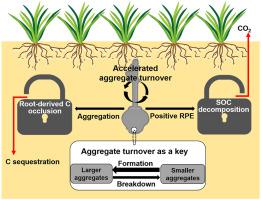Soil Biology and Biochemistry ( IF 9.7 ) Pub Date : 2020-08-20 , DOI: 10.1016/j.soilbio.2020.107964 Xiaohong Wang , Liming Yin , Feike A. Dijkstra , Jiayu Lu , Peng Wang , Weixin Cheng

|
The root-driven soil aggregate turnover dynamics and rhizosphere priming effect (RPE, changes in soil organic carbon (SOC) decomposition caused by living roots) are central to the understanding of SOC cycling. However, the association between aggregate turnover and the RPE has not been illuminated in plant-soil systems because of methodological difficulties. Using rare earth oxides to trace the transformations among different aggregates and 13C natural abundance labeling, we for the first time simultaneously investigated aggregate turnover and the RPE at two phenological stages of two grass species (Agropyron cristatum and Koeleria cristata): tillering (40 days after planting, DAP40) and jointing-heading (DAP63). We found that aggregate turnover rates varied widely, with a range between 0.006 day−1 and 0.024 day−1, i.e., turnover times (the reciprocal of turnover rates) ranged from 41 to 168 days, and were significantly influenced by plant species, sampling date and their interaction. Particularly, greater aggregate turnover rates (2% ~ 68%) and transformations in breakdown and formation pathways were found for K. cristata than for A. cristatum at DAP63. The RPEs increased with plant growth and ranged from −29% to +163%. Especially, the RPE and microbial biomass C were significantly greater for K. cristata than for A. cristatum at DAP63. Root-driven aggregate turnover was tightly associated with the RPE, possibly because of the release of aggregate-protected C for microbial decomposition. There was no net C loss mainly because increased aggregate formation could have sequestrated root-derived C in macroagrgegates and thus counteracted the C loss by the positive RPE. We therefore propose a new framework of root-driven aggregate turnover for considering how plant roots influence SOC dynamics via aggregate turnover. Root-accelerated aggregate turnover acts as a “key”: enhancing SOC decomposition (i.e. RPE), while simultaneously accelerating the occlusion of root-derived C and thus facilitating new C sequestration. This framework highlights that living root-driven aggregate turnover alters the physical protection of SOC and regulates the RPE, which aligns well with the emerging perspective of SOC stabilization.
中文翻译:

根际启动与根驱动的总周转紧密相关
根源驱动的土壤团聚体更新动力学和根际启动效应(RPE,由生根引起的土壤有机碳(SOC)分解的变化)对于了解SOC循环至关重要。但是,由于方法上的困难,总的周转量与RPE之间的关联在植物-土壤系统中尚未阐明。我们使用稀土氧化物追踪不同聚集体之间的转化和13 C自然丰度标记,我们首次同时调查了两种草种(Agropyron cristatum和Koeleria cristata)两个物候期的聚集体周转率和RPE):分till(播种后40天,DAP40)和拔节(DAP63)。我们发现总周转率变化很大,范围在0.006天-1和0.024天-1之间,即周转时间(周转率的倒数)在41天到168天之间,并且受植物种类,采样的影响很大。日期及其互动。特别地,较大的聚集体的周转率(2%〜68%),并在击穿和形成途径转化都发现K.鸡冠花比A.草在DAP63。RPE随着植物的生长而增加,范围从-29%到+ 163%。特别是,K。cristata的RPE和微生物生物量C明显大于K. cristata。DAP63上的A. cristatum。根驱动的骨料周转率与RPE紧密相关,这可能是因为释放了被骨料保护的C用于微生物分解。没有净碳损失,主要是因为增加的聚集体形成可能已经隔离了大型集聚物中根源的碳,因此通过正RPE抵消了碳损失。因此,我们提出了根驱动的总营业额的新框架,以考虑植物根如何通过总营业额影响SOC动态。根加速聚合周转作为“钥匙”:加强SOC分解(我。Ë。RPE),同时加速了根源C的阻塞,从而促进了新的C隔离。该框架强调,由根系驱动的总营业额改变了SOC的物理保护并调节了RPE,这与新兴的SOC稳定观点非常吻合。


























 京公网安备 11010802027423号
京公网安备 11010802027423号